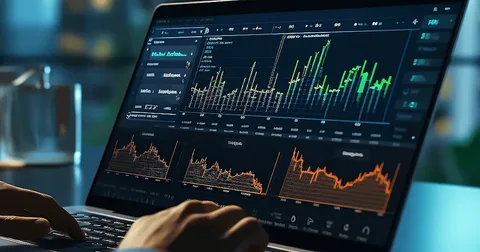Trading is exciting, but it comes with inherent risks. Every trader, whether beginner or professional, must understand that losing trades are inevitable, but losing too much capital can be avoided with proper risk management strategies.
On platforms like 9XMarkets, traders have access to a variety of assets, including forex, cryptocurrencies, and CFDs. While opportunities for profit are significant, the risk of losses is equally high if trades are not managed carefully.
This guide will explore the top 5 risk management strategies every trader should know. Implementing these strategies will help you protect your capital, minimize losses, and trade with more confidence. Whether you’re using a Standard, Premium, or ECN account on 9XMarkets, these strategies are essential for sustainable trading success.
By the end of this article, you’ll understand how to control risk, make smarter trading decisions, and develop a disciplined trading approach that aligns with your financial goals.
1. Set Stop-Loss Orders
One of the most fundamental tools in risk management is the stop-loss order. This tool automatically closes a trade at a predefined price level to limit potential losses.
Why Stop-Loss Matters
-
Prevents emotional decision-making during market volatility
-
Helps maintain capital preservation
-
Allows traders to plan risk-reward ratios before entering a trade
How to Use Stop-Loss on 9XMarkets
-
Identify the maximum loss you are willing to take per trade.
-
Set the stop-loss at a logical level based on support and resistance, volatility, or technical analysis.
-
Adjust only when market conditions justify it, not out of fear or greed.
Example:
If you buy EUR/USD at 1.1200 and set a stop-loss at 1.1150, your maximum loss is 50 pips, protecting your account from larger unexpected moves.
Tip: Combine stop-loss with position sizing (covered next) to control overall risk per trade effectively.
2. Use Proper Position Sizing
Position sizing refers to the amount of capital allocated to a single trade. Proper sizing ensures that no single trade can significantly impact your overall portfolio.
Key Guidelines
-
Risk no more than 1–2% of your account per trade
-
Adjust position size based on volatility of the asset
-
Combine with stop-loss to calculate the exact lot size or units to trade
Example:
With a $5,000 account, risking 2% per trade means a maximum loss of $100. If your stop-loss is 50 pips, you calculate your position size so that a 50-pip move equals $100.
Benefits:
-
Preserves capital during a losing streak
-
Reduces emotional stress
-
Creates consistency in trading performance
Tip: Position sizing is often overlooked but is one of the most powerful risk management tools.
3. Diversify Your Trades
Another key strategy is diversification—spreading your trades across multiple assets or markets to reduce risk exposure.
Why Diversification Matters
-
Limits impact of a single market movement
-
Protects against sudden volatility in one asset
-
Encourages balanced trading decisions
How to Diversify on 9XMarkets
-
Trade a mix of forex, commodities, and cryptocurrencies
-
Avoid putting all capital into one currency pair or coin
-
Combine short-term and long-term trades to balance risk
Example:
Instead of risking all funds on BTC/USD, a trader may allocate 40% to forex, 30% to crypto, and 30% to CFDs. Losses in one market can be offset by gains in another.
Tip: Diversification does not eliminate risk entirely, but it reduces the impact of unforeseen losses.
4. Maintain a Risk-Reward Ratio
Every trade should have a planned risk-reward ratio, which compares the potential profit to potential loss.
Why It’s Important
-
Helps identify high-probability trades
-
Prevents chasing losses
-
Encourages disciplined trading
Guideline:
-
Target a risk-reward ratio of at least 1:2, meaning you aim to gain $2 for every $1 risked.
Example:
If you risk $50 on a trade (stop-loss), you should aim for a minimum profit of $100 (take-profit). Even with a 50% win rate, your account can still grow.
Tip: Always define stop-loss and take-profit levels before entering a trade to stick to your plan.
5. Keep Emotions in Check
Psychology is a crucial part of risk management. Emotional trading often leads to impulsive decisions, overtrading, and larger losses.
Key Tips for Emotional Control
-
Stick to your trading plan and predefined risk levels
-
Avoid chasing losses or revenge trading
-
Take breaks after a series of losses or gains
Example:
A trader loses two trades consecutively but follows the plan and limits risk to 2% per trade. By maintaining discipline, they avoid compounding losses through emotional reactions.
Tip: Consider keeping a trading journal to track decisions, mistakes, and emotional triggers.
Conclusion
Effective risk management is the cornerstone of long-term trading success. On platforms like 9XMarkets, traders have access to advanced tools, multiple account types, and diverse markets—but without proper risk management, capital can vanish quickly.
The top 5 strategies every trader should implement are:
-
Set Stop-Loss Orders – Limit losses automatically
-
Use Proper Position Sizing – Control risk per trade
-
Diversify Your Trades – Reduce exposure to one market
-
Maintain a Risk-Reward Ratio – Plan potential profit vs. loss
-
Keep Emotions in Check – Follow discipline and trading plans
By following these strategies, traders can protect their capital, improve consistency, and trade confidently. Risk management is not optional—it’s essential. Whether you’re a beginner starting with a Standard account or a professional using ECN on 9XMarkets, these strategies will help you trade smarter and achieve long-term success.
